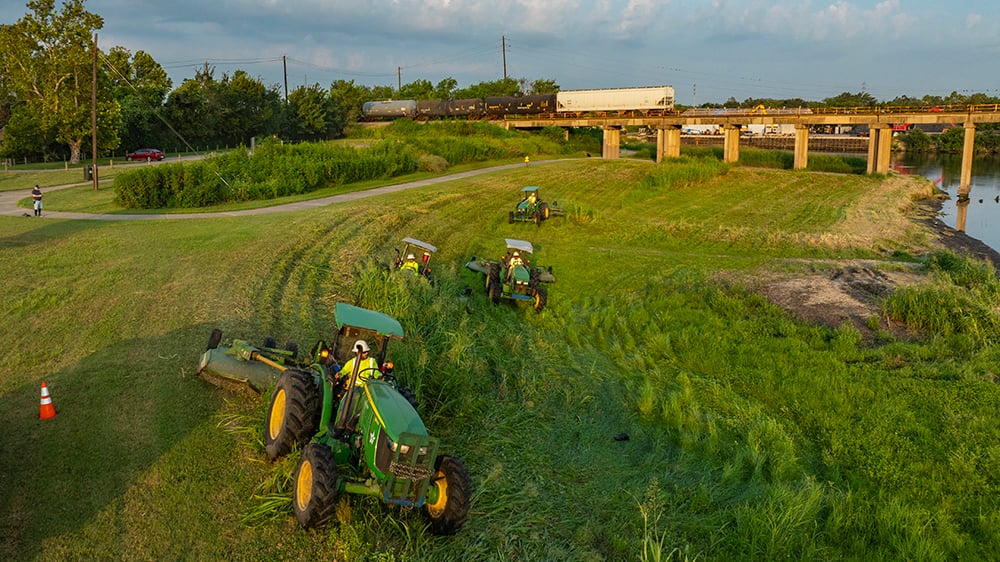
Discover How Harris County Flood Control District Uses Strategic Mowing to Prevent Flooding and Protect Communities
Every year, as grass grows across the expansive bayous and drainage channels of Harris County, so too does the need for vigilant vegetation management. What might look like routine mowing is actually a critical component of regional flood prevention efforts managed by the Harris County Flood Control District (HCFCD).
Created by the Texas Legislature in 1937, the HCFCD was established in direct response to catastrophic floods in 1929 and 1935. The district, which serves more than 4.7 million residents across the 1,777-square-mile expanse of Harris County—including the City of Houston—oversees a network of 23 watersheds, each with its own unique flood challenges. Today, the Flood Control District remains laser-focused on reducing flood risks and protecting vital infrastructure.
One of the often-overlooked but essential services provided by HCFCD is its mowing program, a key part of the agency’s broader vegetation management strategy that ensures stormwater continues to flow unimpeded during heavy rains.
Why Mowing Matters for Flood Control
The HCFCD maintains more than 2,500 miles of grass-lined channels, dozens of large stormwater detention basins, and roughly 2,300 buyout lots—amounting to over 18,000 acres of land that must be carefully managed throughout the growing season.
Mowing may seem cosmetic, but it plays a crucial role in the performance of these stormwater systems. The Flood Control District mows to:
-
Control undesirable woody species that can obstruct flow.
-
Encourage dense grass growth, which helps prevent soil erosion.
-
Maintain accessibility for inspections and maintenance of channels.
-
Present a generally well-kept appearance for the public.
These activities contribute directly to the efficiency of flood control systems, ensuring stormwater moves swiftly through channels during extreme weather events.
Mobile Sidebar Ad
How Often Does Harris County Flood Control District Mow?
The mowing schedule is guided by seasonal growth patterns and varies slightly year to year based on weather, but the general timeline is as follows:
-
Channels and stormwater detention basins: Mowed three times between May and November.
-
Buyout lots: Mowed monthly from April through November.
-
Multi-Service Areas (e.g., Clear Lake, Mason Creek watersheds): Mowed as needed, especially to manage aggressive species like Johnson grass and keep vegetation below 24 inches.
While tall grass does not impede water flow—thanks to the way grass stems bend with rushing water—the presence of woody-stemmed vegetation, sediment, and debris can block or redirect water, increasing flood risk. Therefore, selective clearing, tree pruning, sediment removal, and herbicide applications are also part of the comprehensive maintenance approach.
Not All Channels Are Mowed Equally
It’s important to note that some channels listed as “Not mowed by HCFCD” on the agency’s interactive mowing map fall under different maintenance guidelines. This can happen when:
-
HCFCD lacks property rights along the channel (e.g., sections of Greens Bayou).
-
The channel has been adopted by other agencies or municipalities, such as the City of Houston or a municipal utility district (MUD).
-
The area features natural landscapes, tree canopies, or ecological restrictions that make mowing unnecessary or undesirable.
In these instances, mowing isn’t neglected—it’s strategically avoided to preserve the integrity of unique ecosystems or because other entities have stepped in to manage the maintenance.
Mobile Sidebar Ad
Partnering With the Community for Extra Mowing and Multi-Use Spaces
HCFCD acknowledges that in some cases, residents or local organizations may want more frequent mowing than the agency’s flood-prevention priorities allow. The district has developed formal agreements that allow for this flexibility:
-
MUDs can take over mowing responsibilities and be reimbursed for up to three mowings annually.
-
Individuals may “adopt a lot” through the Open Space Program, volunteering to maintain buyout properties.
-
HOAs can develop public recreation agreements to use stormwater detention basins as parks or sports fields, which include mowing provisions.
For those interested in supporting their local environment or creating recreational spaces, these community partnerships offer a valuable opportunity to collaborate with HCFCD in a mutually beneficial way.
A Vital Function You Might Not Notice
The work of the Harris County Flood Control District often flies under the radar—until a storm hits. But year-round, the agency is mowing, pruning, clearing, and maintaining the land to protect lives and property.
Residents are encouraged to explore the Flood Control District’s mowing and maintenance resources, including the interactive mowing map and Open Space Program, or call 713-684-4000 to speak with the Community Services Division.
By raising awareness of these behind-the-scenes efforts, HCFCD continues to reinforce its mission: to reduce the risk of flooding through responsible, cost-effective infrastructure management—not beautification, but protection.
 Tiffany Krenek has been on the My Neighborhood News team since August 2021. She is passionate about curating and sharing content that enriches the lives of our readers in a personal, meaningful way. A loving mother and wife, Tiffany and her family live in the West Houston/Cypress region.
Tiffany Krenek has been on the My Neighborhood News team since August 2021. She is passionate about curating and sharing content that enriches the lives of our readers in a personal, meaningful way. A loving mother and wife, Tiffany and her family live in the West Houston/Cypress region.








